Astrolabe 7: The Fall of Shannara, Phantasy Star, And How Terry Brooks Changed My Life

How Terry Brooks Changed My Life
Everybody has a critical path through life.
The points along this path are the unique moments that define us—whether they’re crossroads, or singular moments of inspiration, trauma, choices, roads taken, roads not taken. Without these, we would not—for good or ill—be who we are today.
Twice, Terry Brooks has proved himself one of the defining points on my life’s critical path, and I can say without hesitation that I would not be where I am now without his influence, kindness, and generosity.
My path to fantasy fiction was fairly standard: I grew up a science fiction fan—Tom Swift, Michael Crichton, Star Trek, etc.—and wouldn’t even give fantasy a glance until I was 11 years old and discovered my mom’s copy of The Hobbit. From there, I jumped into Lord of the Rings, and fervently needed more after that. So, back to my mom, the prime SFF geek in my life, and she handed me a copy of The Sword of Shannara by Terry Brooks.
Where Tolkien introduced me to the concept of fantastical secondary worlds, sweeping adventures, heroic archetypes, and all the other things that defined epic fantasy for decades, Terry Brooks took those concepts, intentionally riffing on Tolkien’s work, and made them accessible and compulsive. With Lord of the Rings, I got a glimpse of something great through the window, but Terry Brooks’s work threw open the doors and invited me in warmly. I like to say that Lord of the Rings turned me into a fantasy fan, but Brooks’s Shannara turned me into an addict.
I devoured all of Brooks’s Shannara books, then leap-frogged to R.A. Salvatore and Raymond E. Feist, which turned me toward Robin Hobb, George R.R. Martin, and Tad Williams. But it’s always been Brooks, and his tales of heroic derring-do in the Four Lands, that remains nestled in my writer’s heart, inspiring me to not just write exciting fantasy adventures, but to fill them with warmth and kindness—with an optimism that always attempts to bring forward the good and brave in its heroes.
Fast forward a few years, and Brooks again changed my life. Fresh out of high school, I attended the Surrey International Writers Conference (which is fabulous, and y’all should take the chance to attend, if that works for you) with my mom in tow. As a young, aspiring writer, I knew it was a good chance to learn from some of the best in the business (I mean, how teenage kids rub shoulders with Donald Maas and Anne Perry at dinner, and casually introduce their mom to Diana Gabaldon?), but the real reason I was attending is because Brooks was teaching classes, and I needed to learn from him directly.
I was an active member of the official Terry Brooks message board at the time, and had made many good friends there, including my still-great friend, Shawn Speakman, who was Brooks’s webmaster. With this in my back pocket, I had a plan to introduce myself to Brooks and thank him for the impact his work had had on my life. I spotted him and his lovely wife, Judine, a few tables away during breakfast of my second day at the conference, and committed the most typically naive-teenage-superfan move: I wandered over and introduced myself. I can’t remember what I said, but I’m sure I embarrassed myself: Meeting your hero as a teenager is a humbling experience. I mentioned our mutual friend Shawn, and Terry remembered that he’d said I’d be at the conference.
And then invited me to join him at breakfast.
😳
I nearly barfed.
After I’d settled my nerves, my mom and I migrated our two-egg-and-sausage breakfasts over to their table, and spent a lovely hour with Terry and Judine. I’d approached a superstar author, who had sold more books than there were people in my entire province (many times over), but who I joined at the table that morning was a humble and kind person, with a clear sense of humour, and an impish laugh he wasn’t afraid to use. Terry could have politely said hello to his young fan before returning pointedly to his breakfast, but instead he was full of questions about my work, and my connection with Shawn and the larger Shannara fan community. We spoke about the conference. He asked questions about what I’d been learning, what plans I had for the future. I don’t think I asked any embarrassing questions about his work. At least, I hope I was cool enough to save those for the book signing.
Terry changed my life that day, because he showed me by example how someone can attain incredible success, but remain humble and kind, generous with their time, and dedicated to their fans—even when they’re interrupting them at breakfast. Before that, I’d seen my idols as somehow above or removed from real life—demi-gods—but Brooks showed me that there are real people behind the success. And I’ve loved him ever since.
Terry’s kindness extended beyond that one meeting, as we bumped into each a few more times at the conference, and later at book signings. Years later, long after the last time we’d spoken in person, he reached out to congratulate me when I won my Hugo.
At every opportunity, Terry embraces kindness, and makes time for the people around him.
After that breakfast in Surrey, I knew I could become a fantasy writer, because that barrier between me and my idols had been shattered. They were not demi-gods. They’re regular people, just like me. And, if they can do it, so can I—even if I have to travel a different path to get there.
And, more than that, I’ve tried to replicate and internalize Terry’s kindness and generosity as I’ve travelled toward my own success. We all have a chance to be one of those points on someone else’s critical path, and I want to make sure, when my time comes, that my impact is positive.
Out & About
(Out & About is where I highlight my work around the web—some recent and some old favourites.)
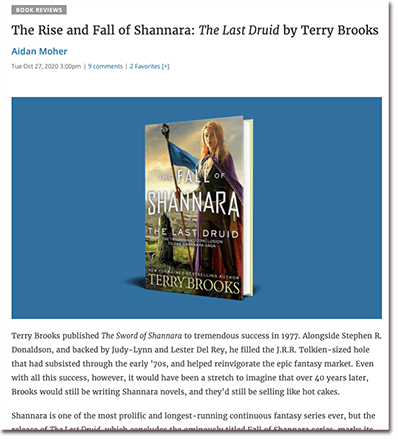
There’s a very good reason I’ve written about Terry Brooks today, and that’s because last week marked the release of The Last Druid, the chronological conclusion to his long-running Shannara series. Over on Tor.com, I’ve got a review of the final book that also doubles as a series overview, and provides a few different recommendations on where to jump on board if you’ve never read Shannara before.
I’m of a few minds here. As a standalone series, The Fall of Shannara is epic, complex, and features some of Brooks’s finest thematic explorations. As a conclusion to the story that started with Ilse Witch, it works well, providing a satisfying climax and believable closure to Brooks’s greatest character. As a conclusion to the entire Shannara series, it feels a little flat, like it’s lost touch with themes and ideas explored in its earliest volume. At I see it, there are two Shannaras: Pre-Grianne Ohmsford, and post-Grianne Ohmsford—and the latter failed over time to ever capture the magic of the former.
Read “The Rise and Fall of Shannara: The Last Druid by Terry Brooks” on Tor.com
Some more:
- Welcome to Rereading Shannara: The Elfstones of Shannara (Tor.com—August, 2015)
- How Terry Brooks Saved Epic Fantasy (Medium—March, 2015)
- The Black Elfstone is the Beginning of the End for Terry Brooks’ Shannara (Barnes & Noble SFF Blog—June, 2017)
LTTP—Phantasy Star IV: The End of the Millennium (Sega, 1995)
( LTTP stands for “Late to the Party” and is a regular column where I let Twitter decide which retro game I’ll play for an hour. Do your worst, Twitter!)
For this issue’s LTTP poll, I loaded up on heavy-hitters and, to my surprise, Phantasy Star IV: The End of the Millennium trounced its stiff competition. I was sort of cheating the rules this time around—by basing the poll around a bunch of games I’d already played—but, perhaps not coincidentally, PSIV is the only game on the list I haven’t completed a bajillion times before!
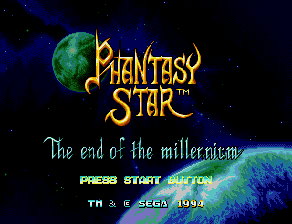
One of my first thoughts while playing PSIV was that it feels more like a souped-up 8-bit game than a full-fledged 16-bit game, especially when you compare it side-by-side with other 1995 titles like Chrono Trigger or Yoshi’s Island—I mean, the PlayStation came out that year!—but it’s important to consider that PSIV came out in Japan at the end of 93, putting it more in line with games like Lufia & The Fortress of Doom or Tecmo’s Secret of the Stars. When you consider it from that perspective, it becomes even more impressive.
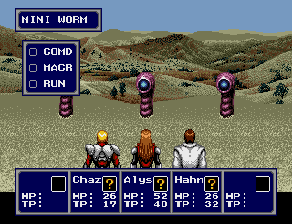
The graphics are plain and generally unimpressive outside of battles, but the art design is focused on a really great ‘80s anime SF aesthetic, and that alone makes it a joy to play. And while its tile-based graphics lack detail, it’s more than made up for by impressive comic book-style illustrated panels that punctuate main story moments—a visual style that feels quintessentially Sega, and helps define Phantasy Star against other similar titles of the time—and paved the way for the more cinematic RPGs that reigned supreme during the next console generation.
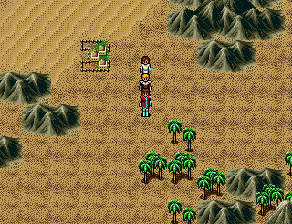
The game’s skill/tech system is frustratingly opaque. Even when the spells/techs have names that make sense, the game gives you no description of what they actually do, and then there’s a whole bunch that just have gibberish names. I imagine long-time fans of the series have adapted, but as a newcomer this was easily my least favourite part of the experience, and I’ll be quickly reaching for a reference guide when I get around to playing the rest of the game.
The combat system, on the other hand, is blazing fast and, though easy, struck me as something I’d be happy to spend 20 hours with. It takes Dragon Quest’s first person-style camera, but adds your characters up-front, which is a nice twist, and the backgrounds are impressive and detailed. The best part, though, is being able to create action-based macros, to cover off the various repeated sequences you often find yourself following during rote JRPG battles, and making them accessible with a single button press.
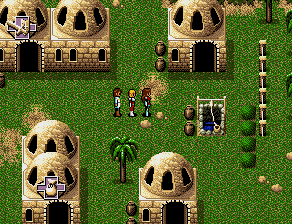
Nakagaki and Numata’s score is terrific fun—mixing a synth-y, almost cyberpunkish sound with traditional JRPG melodies and beats, creating something that’s at once unique for the era, but also familiar and comforting. I was immediately reminded of Zeboyd Games’s Cosmic Star Heroine, which wears its Phantasy Star influence on its sleeve.
It feels impossible to discuss one of the seminal 16-bit JRPGs without comparing it to its contemporaries, but, perhaps one of the Phantasy Star series’s most notable elements is that it was developed and published by Sega. Nintendo facilitated the JRPG boom on the NES and SNES by publishing many landmark titles—including Final Fantasy and Dragon Quest—but even first party JRPGs like Earthbound were developed by outside studios. Sega not only tackling the JRPG genre directly, but taking it by storm and creating one of the most widely respected games of the generation is remarkable.
You can watch my LTTP stream for Phantasy Star IV: The End of the Millennium on Twitch.
Phantasy Star IV: The End of the Millennium was first released for the Sega Genesis in December, 1993, and arrived in North America in February, 1995. It wasn’t released in Europe until December, 1995—a few months after the PlayStation came out. It’s currently available on many platforms, including Steam.
Recommended Reads
Shadows Cast By Stars by Catherine Knutsson
Catherine Knutsson’s 2012 novel, Shadows Cast by Stars, takes place on a fictionalized version of Vancouver Island—where I live—in the near future after a viral pandemic has taken hold of most of humanity. People of indigenous descent have antibodies against the virus, making them targets for a government seeking to harvest those antibodies to protect the masses. Cassandra Mercredi and her brother Paul escape to The Island, protected by a magical barrier that keeps the outside world out, and it’s there that their adventure truly begins. Knutsson belongs to the the Métis nation, and her book is wound through with themes exploring identity, mixed heritage, and belonging. It’s a beautiful story, bursting with strong women, incredible worldbuilding, and a heady mix of science fiction, fantasy, and indigenous storytelling.
Find out more about Shadows Cast By Stars by Catherine Knutsson
Quest Markers
(Quest Markers is a collection of the coolest stuff I’ve read around the web lately.)
- Making the connection: How Eden Robinson's best-selling novel 'Son of a Trickster' came to the screen by Michelle Villagracia (CBC)
- Tamsyn Muir Is Ready To Write About Cyberpunk Lesbian Gunslingers by K.W. Colyard (Bustle)
- Personal Canons: Ender's Game by Ty Schalter (Here’s The Thing)
- Dear Tolkien Fans: Black People Exist by Christina Warmburnn (The Public Medievalist)
- Coaching an athlete in transition by Denis Vachon (CBC Sports )
- Download this Free Africanfuturism Anthology! (Tor.com)
- Authors Talk About The State of Modern Fantasy at NYCC by Andrew Liptak (Tor.com)
- Strange Horizons Reviews: A Twentieth-anniversary Round Table (Strange Horizons)
- Pokémon: The Japanese game that went viral by Matt Alt (BBC)
- Putting Identity to Ethnicity; Dark-skinned Heroes and Villains in Gaming by Julian Woodyard (Medium)
- The Women Who Invented Video Game Music by Dia Lacina (Wired)
- N.K. Jemisin on the Timeless Power of Fantasy by N.K. Jemisin (Time)
- Life, Liberty, and the Pursuit of Excellence by Nibedita Sen (Uncanny Magazine)
End Step
I’m not crying—you’re crying!
One of the reasons I started Astrolabe was so I’d have a place to pay forward the love and kindness I’ve received over the years from the writing and SFF communities, and it really means a lot to me to be able to write about Terry Brooks and his amazing generosity. I’d love to hear from you about the people who’ve changed your life over the years, so get in touch!
Support
There are lots of ways to support Astrolabe and my other work. Check ‘em out!
- Patreon: http://patreon.com/adribbleofink
- Ko-fi: http://ko-fi.com/aidanmoher
- Paypal: http://paypal.me/AidanMoher
Keep In Touch
Enjoy Astrolabe? Want more SFF and retro gaming goodies? You can find me on Twitter and my website.
Credits
Astrolabe banner photo by Shot by Cerqueira on Unsplash

